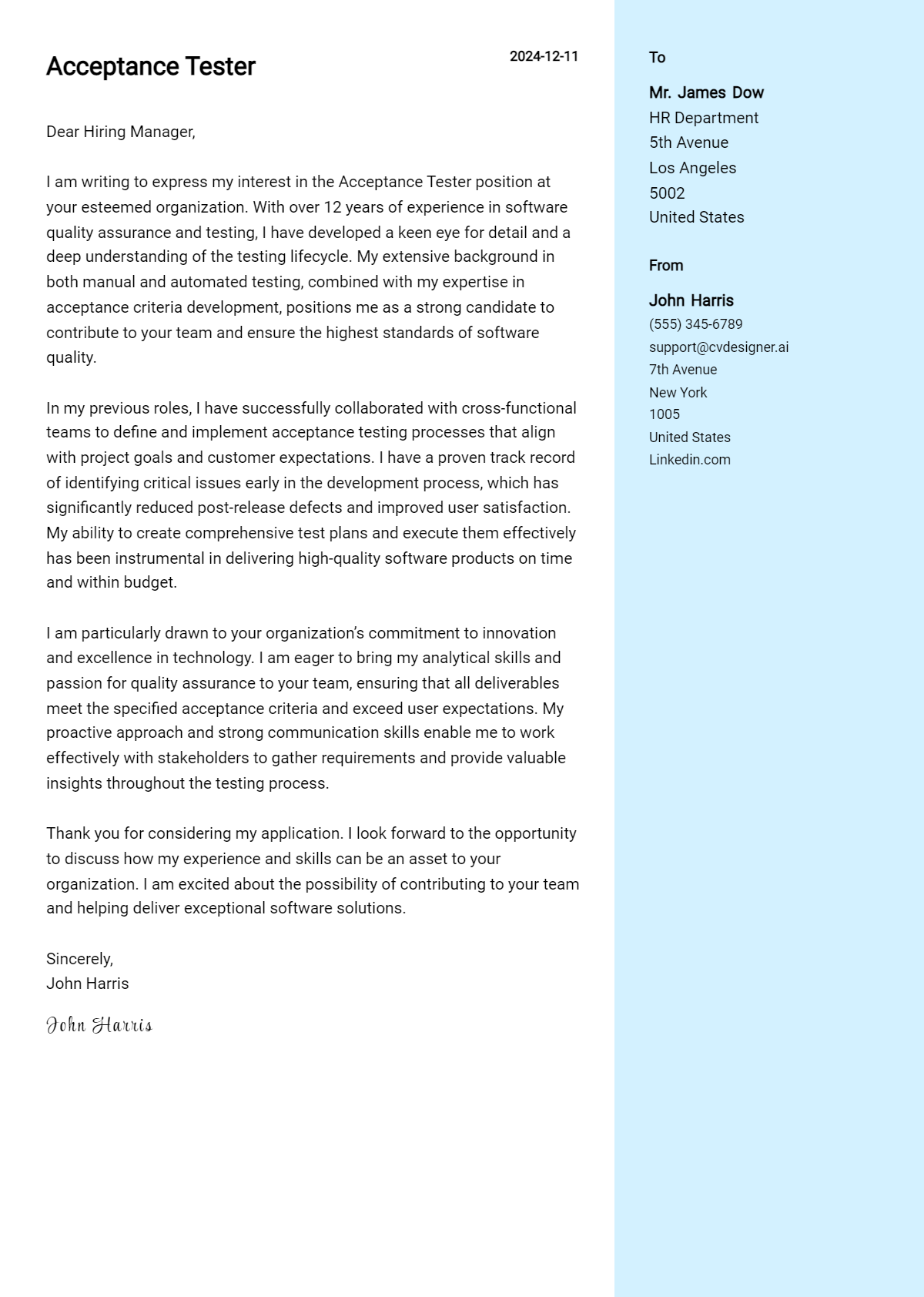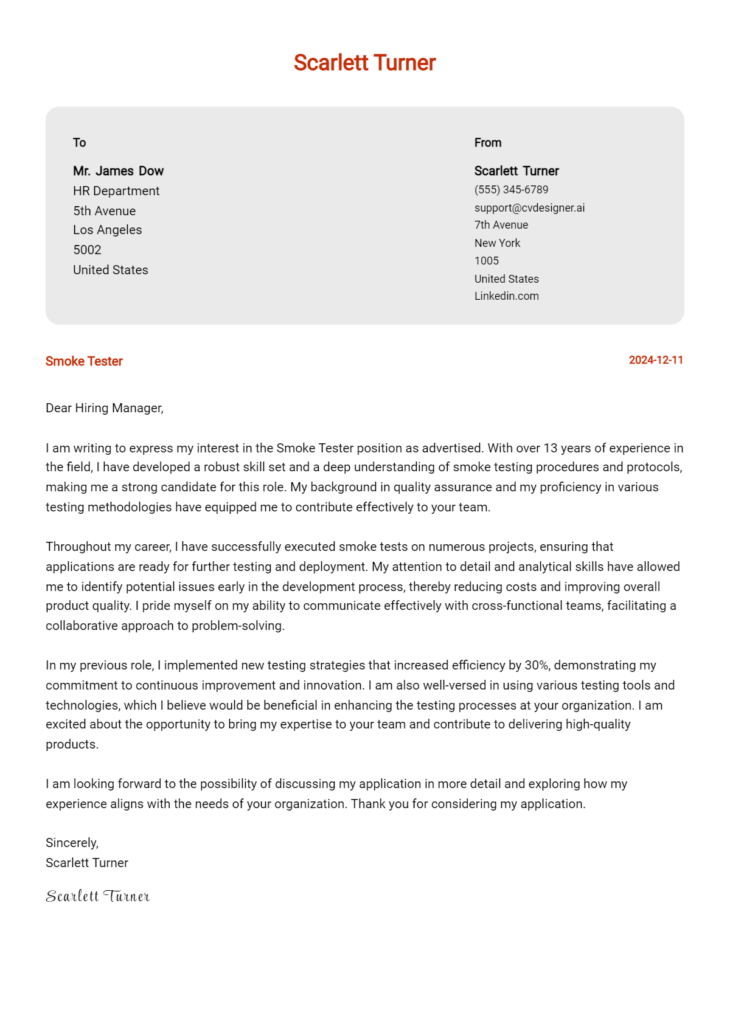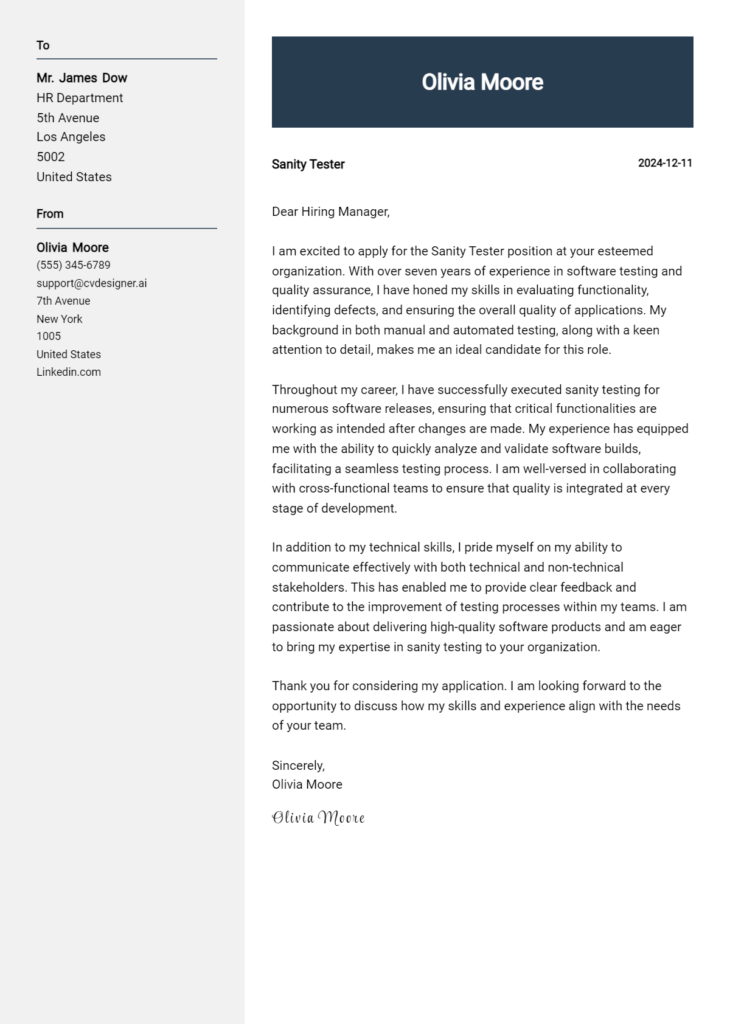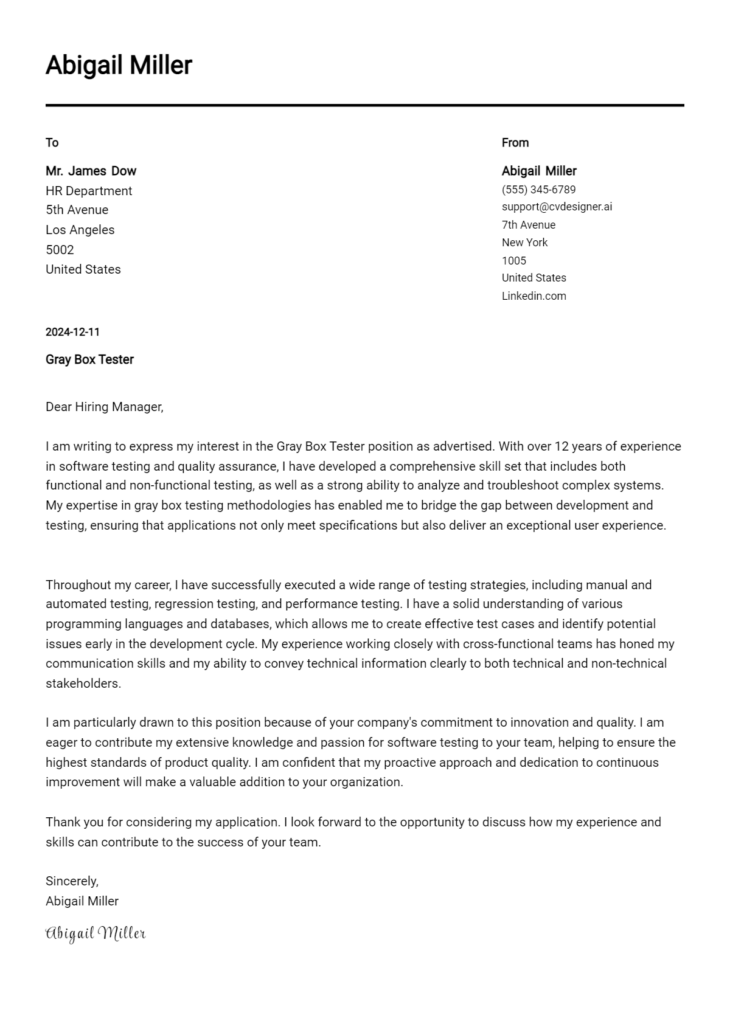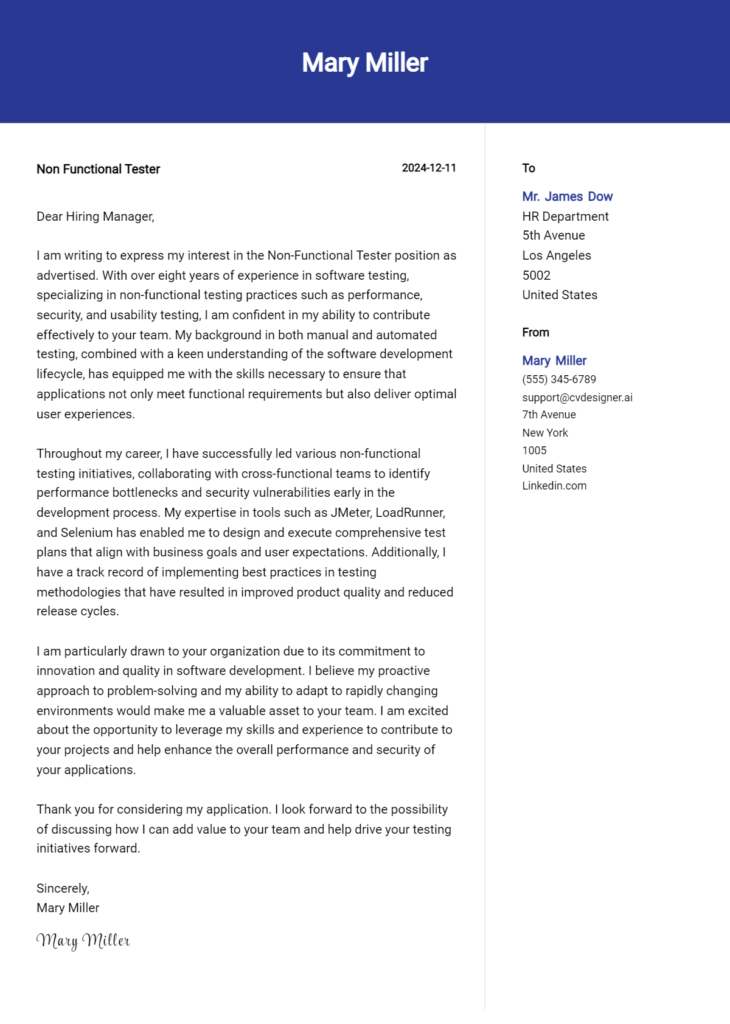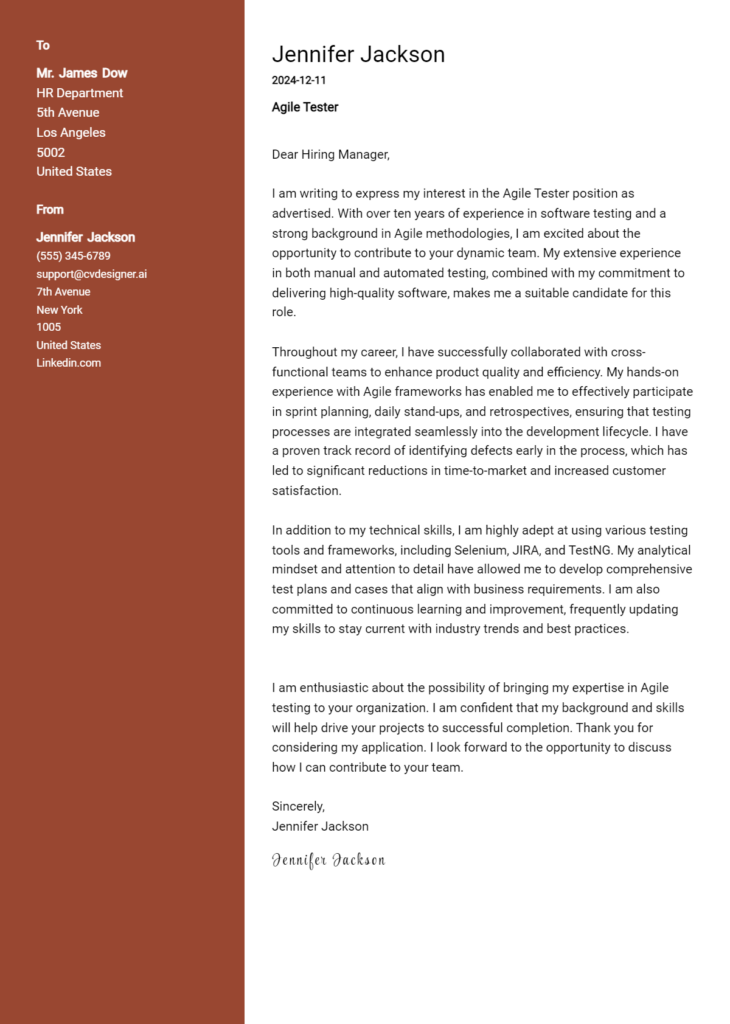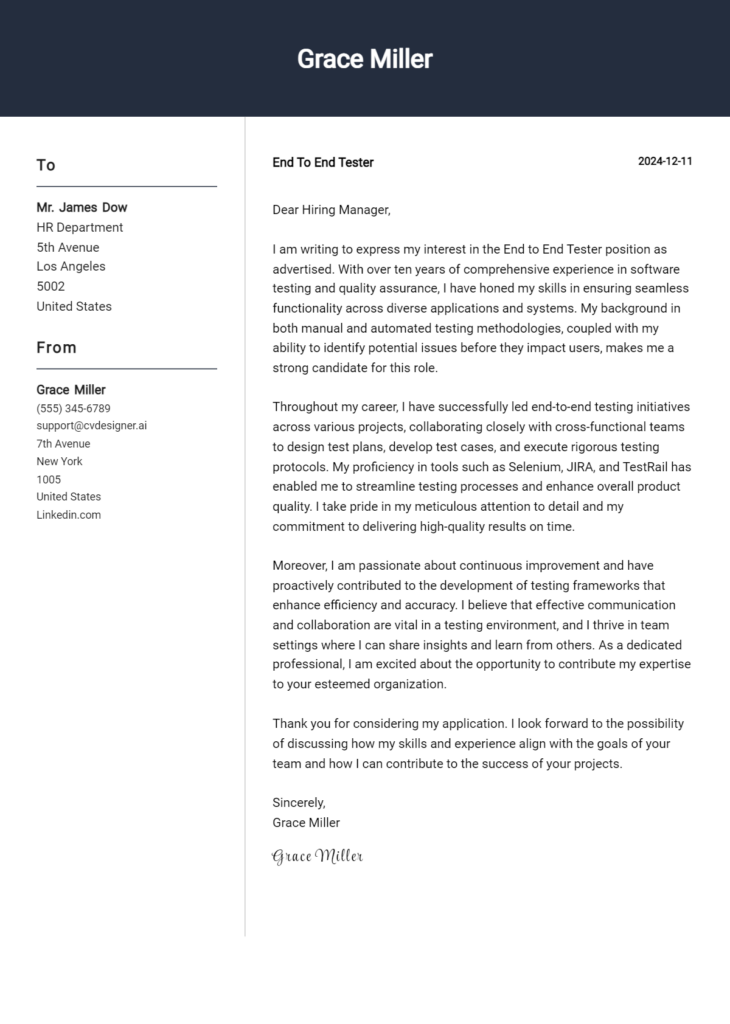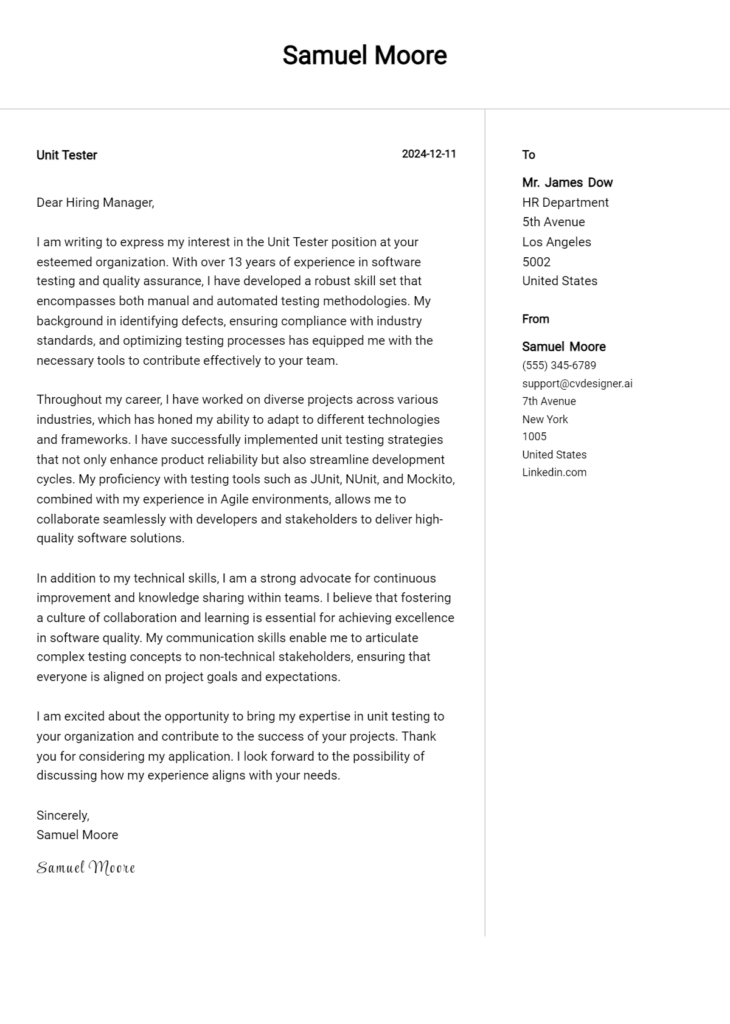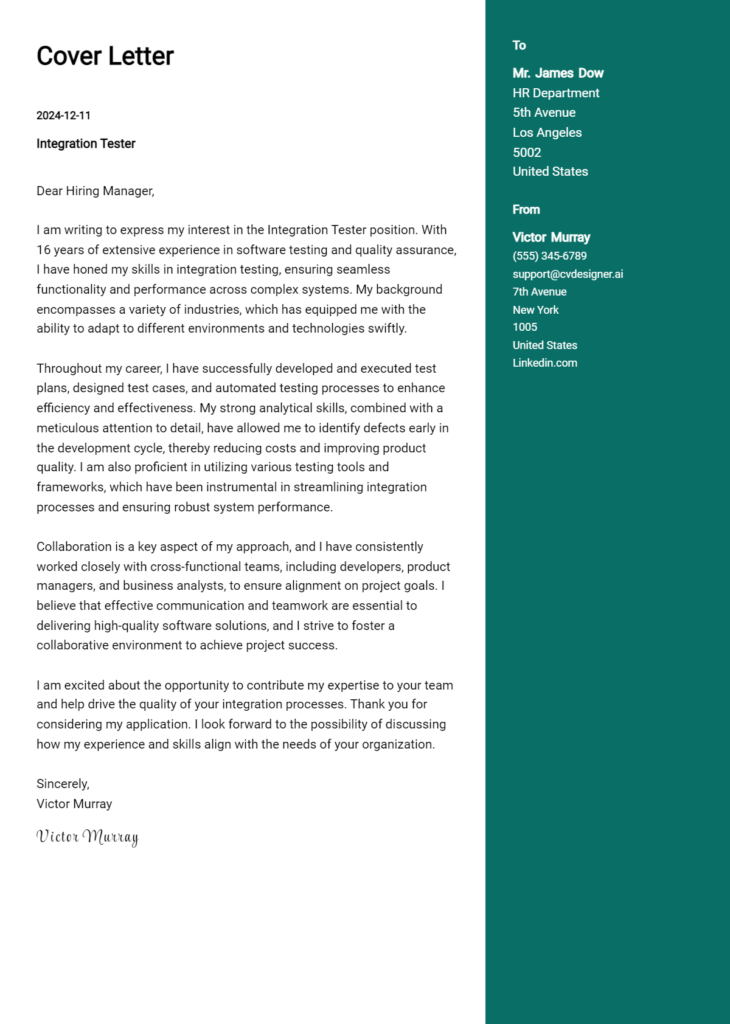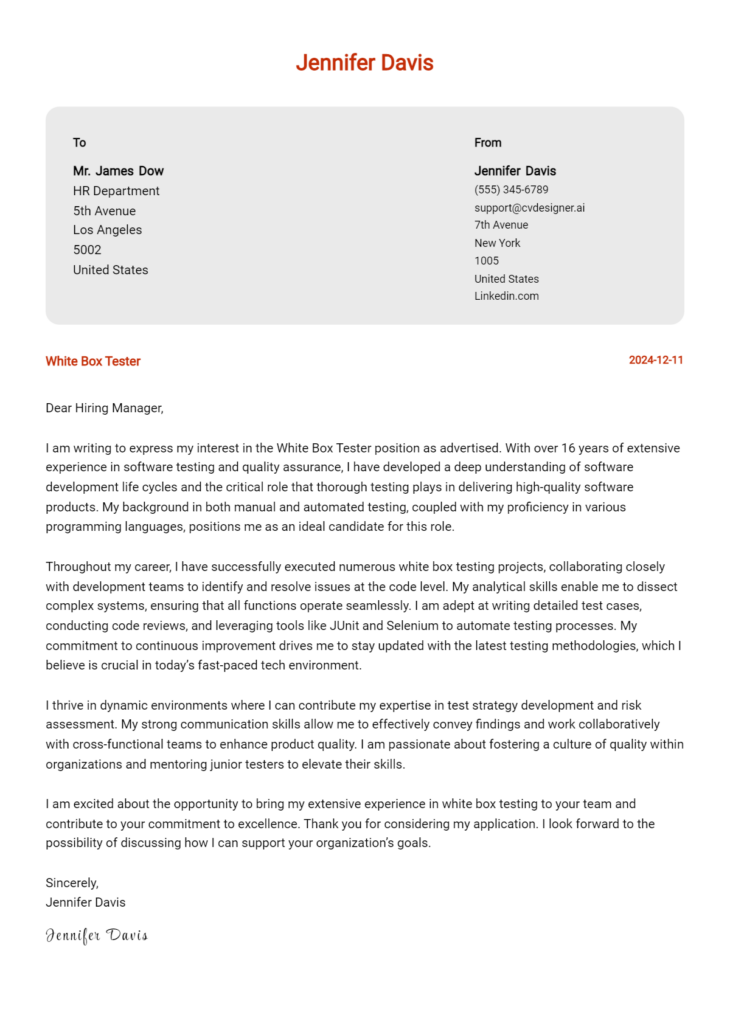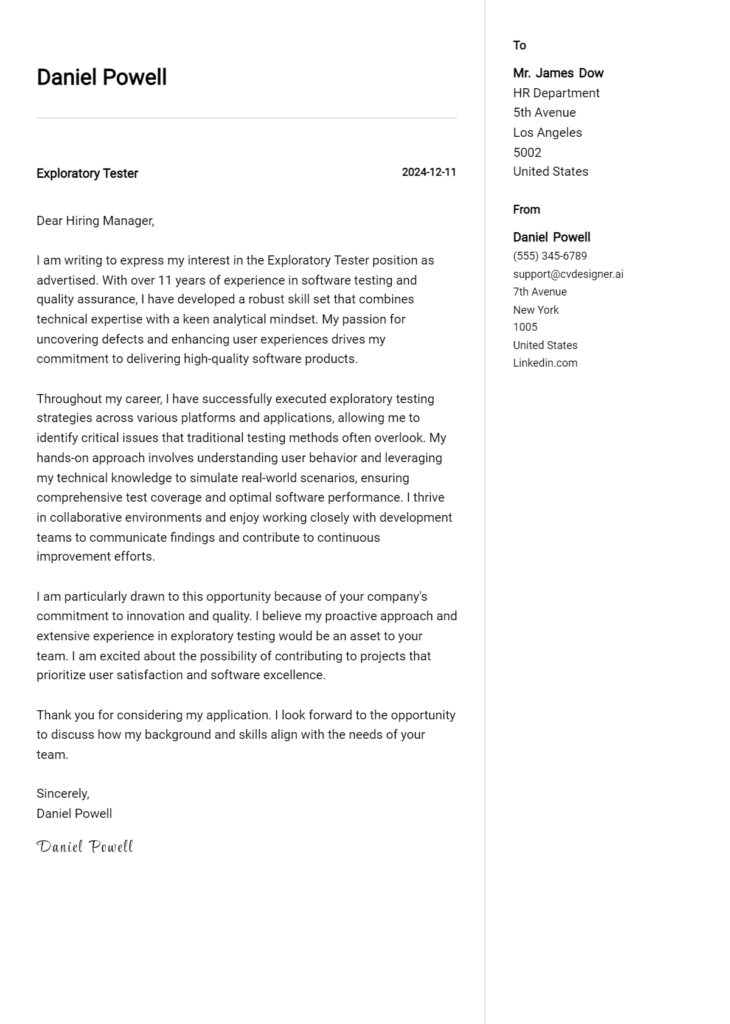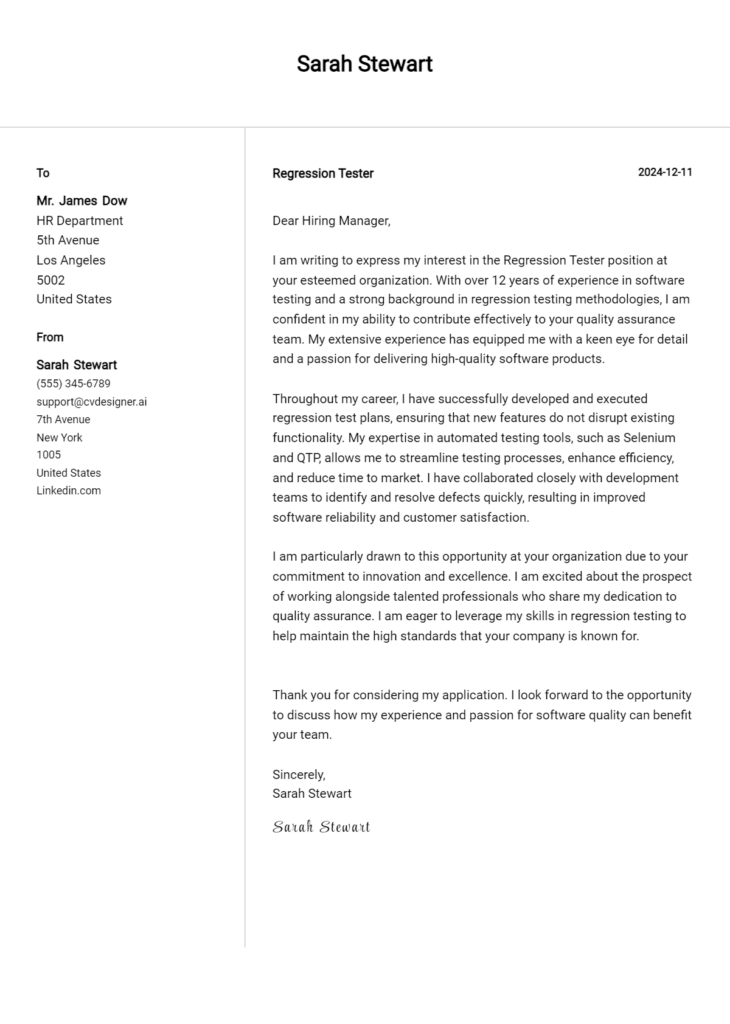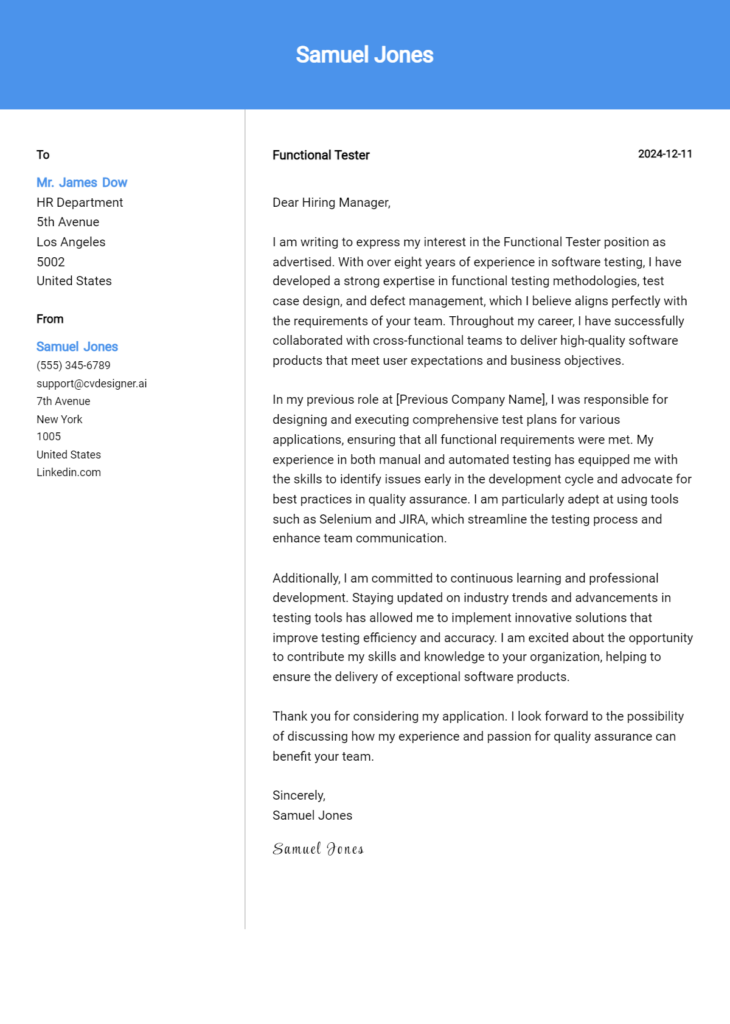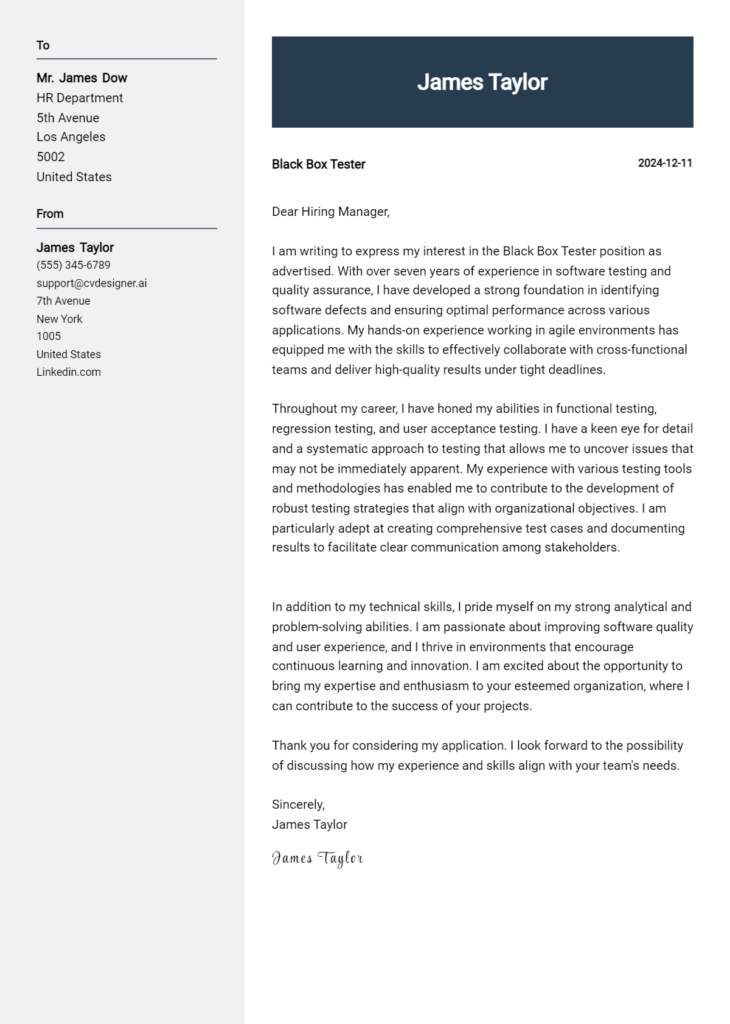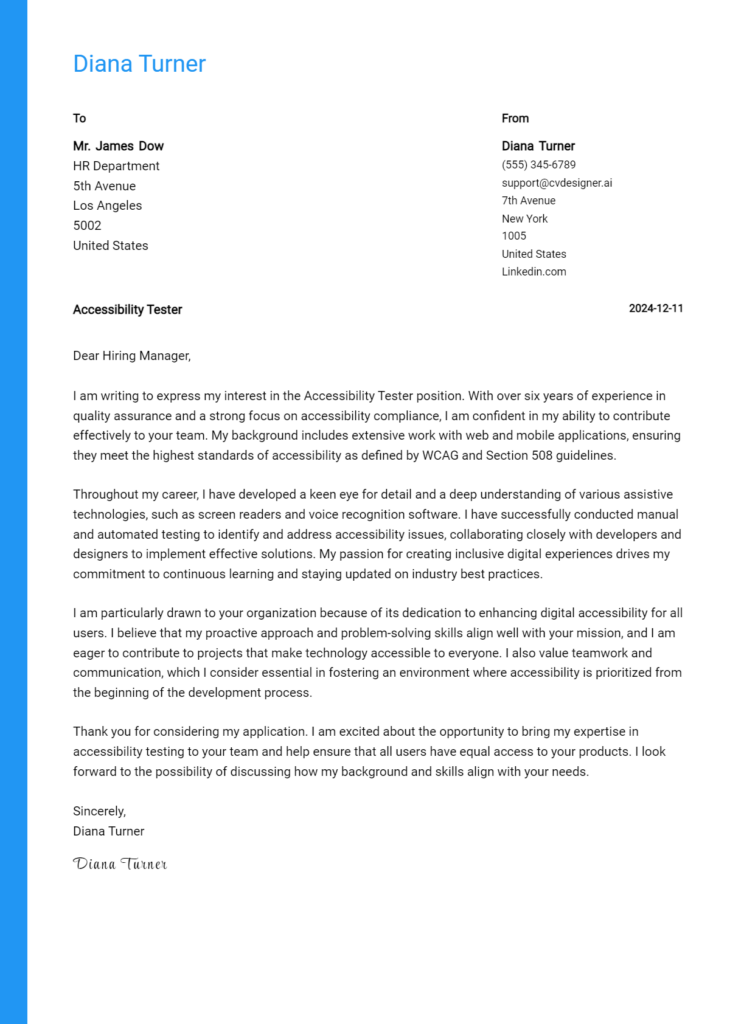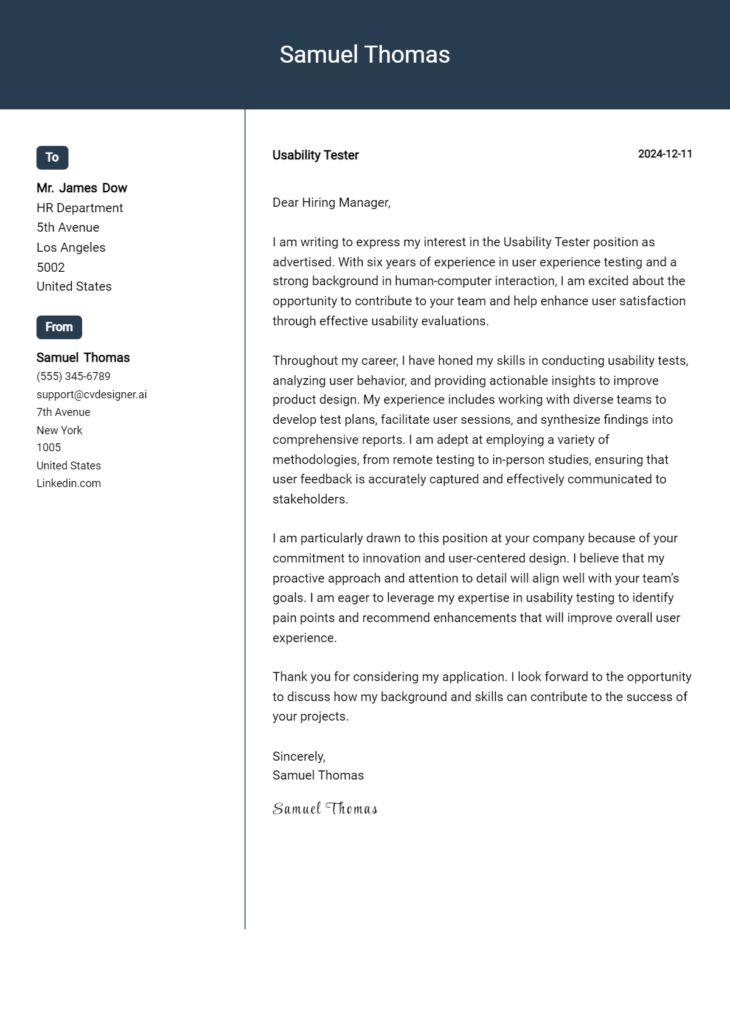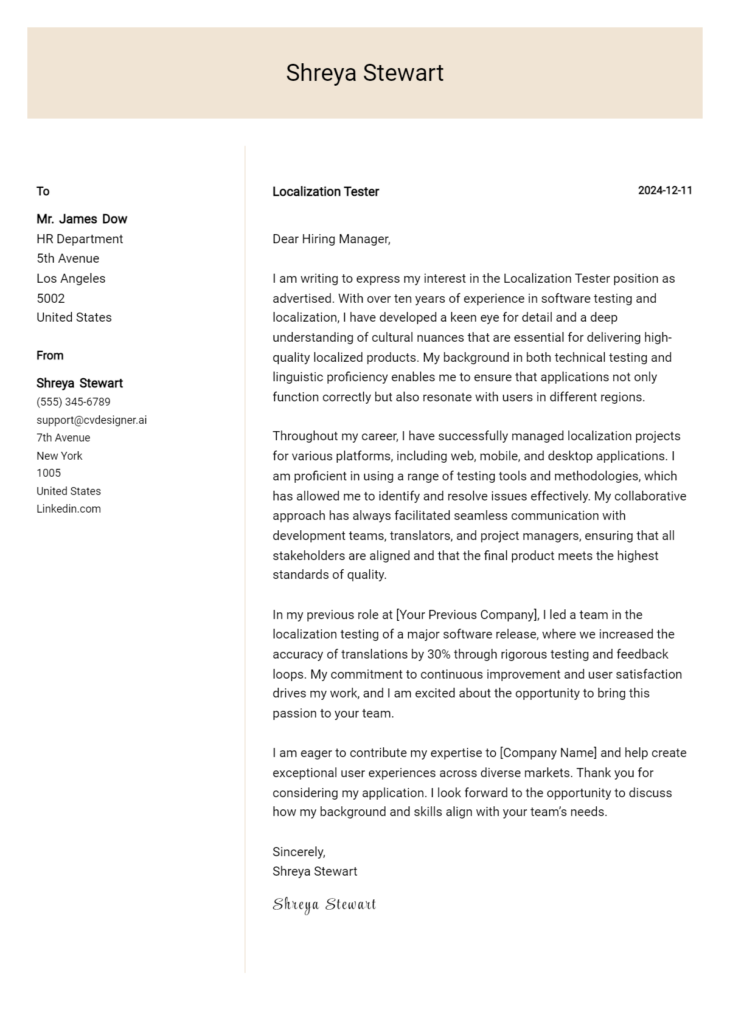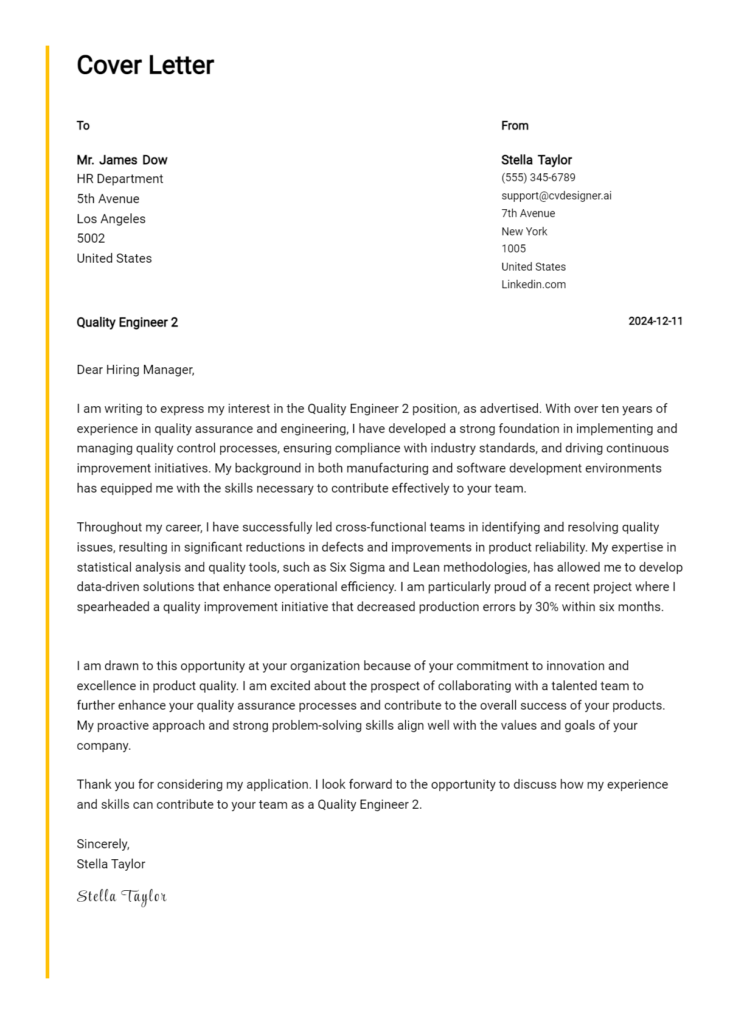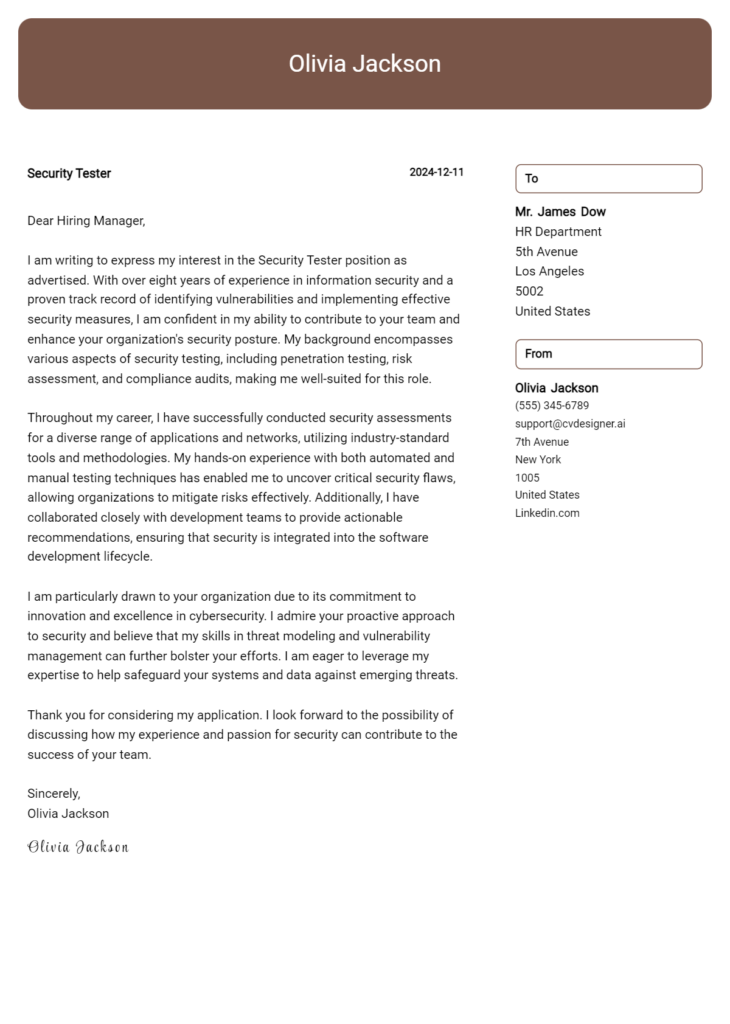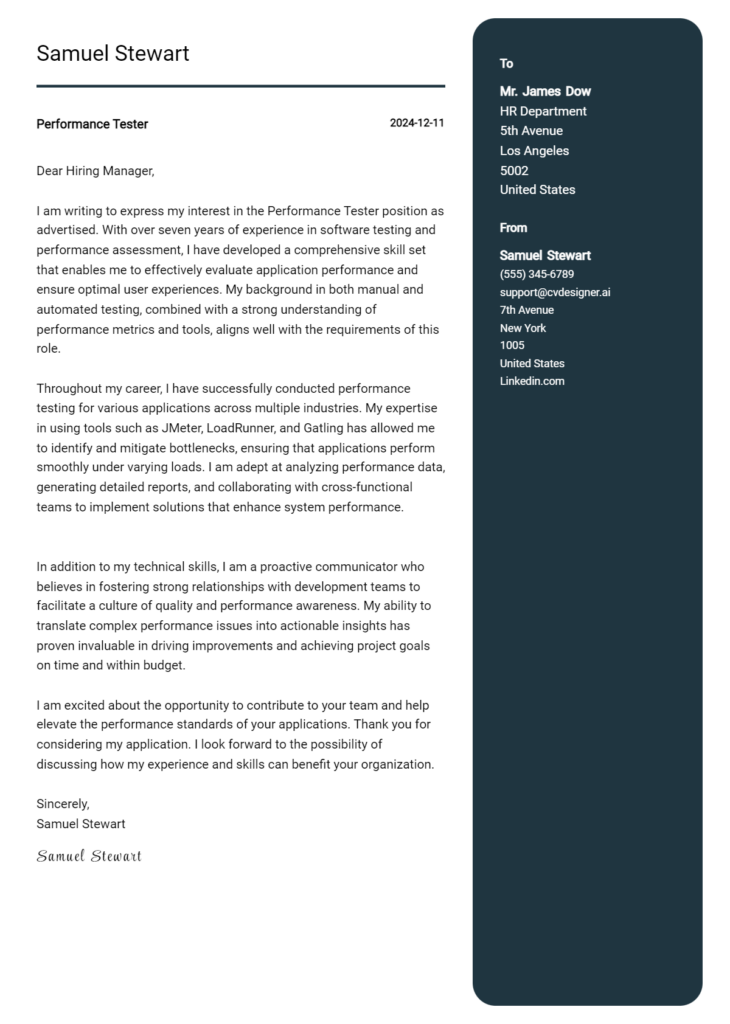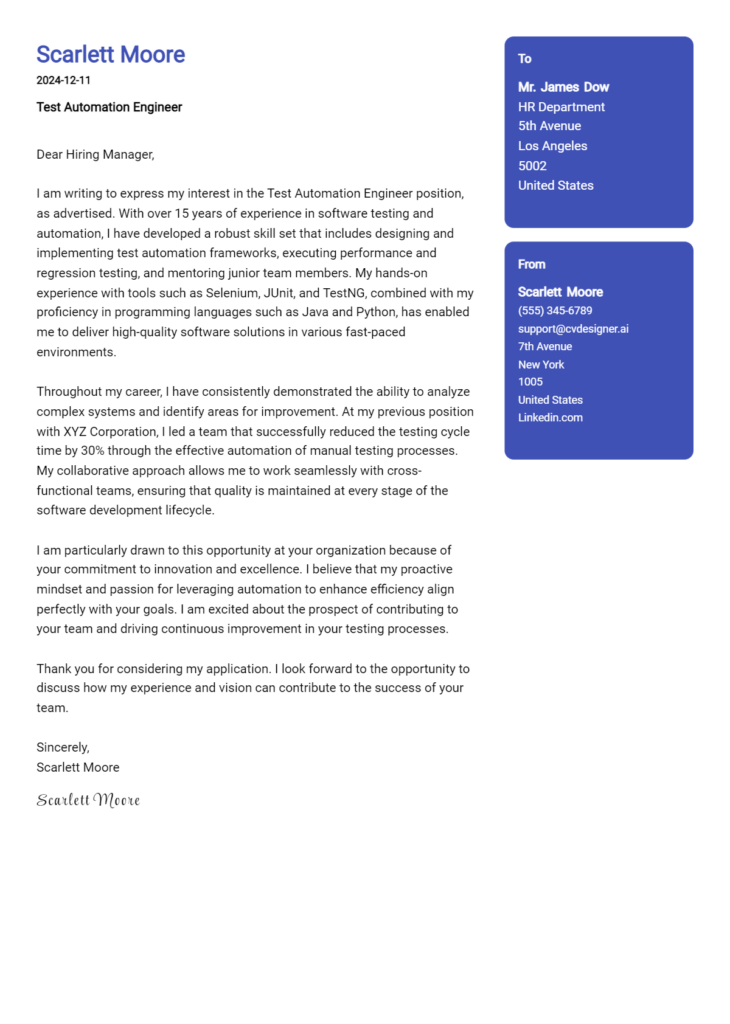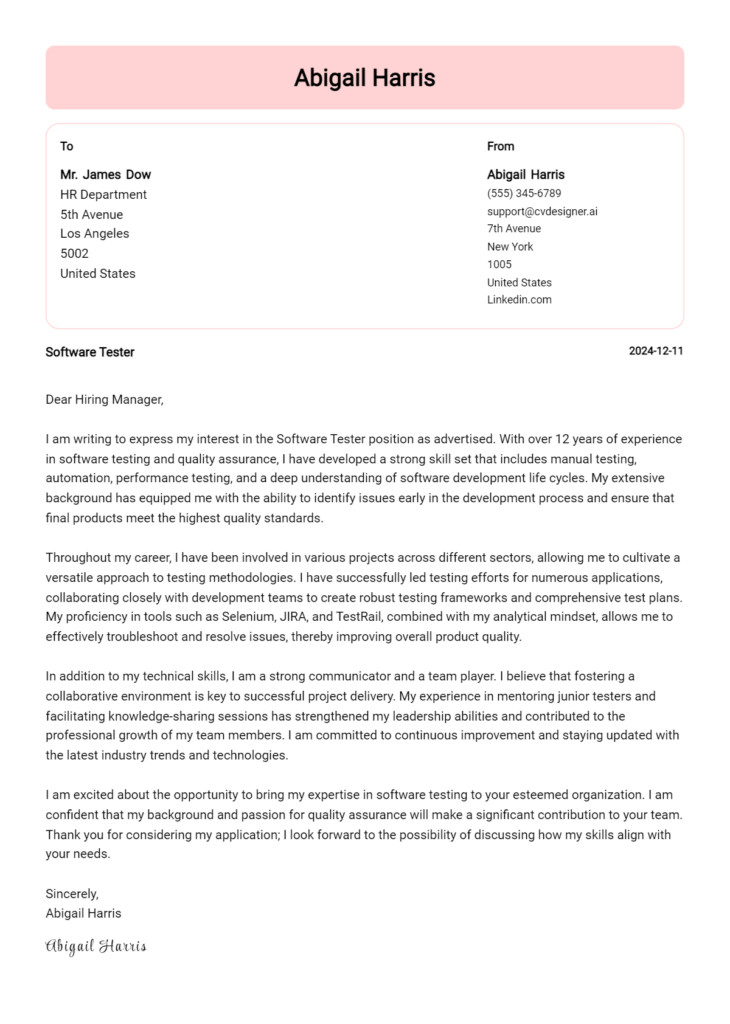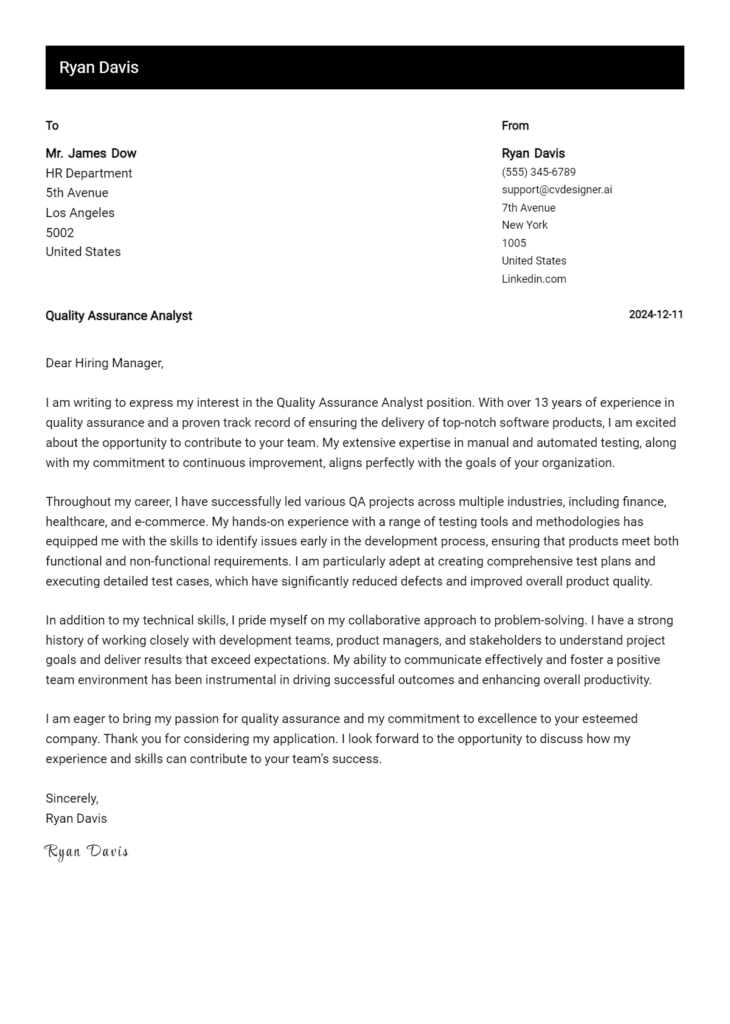Acceptance Tester Cover Letter Examples
Explore additional Acceptance Tester cover letter samples and guides and see what works for your level of experience or role.
How to Format an Acceptance Tester Cover Letter?
Crafting an effective cover letter is essential for an Acceptance Tester, as it serves as your first opportunity to showcase your skills and attention to detail. The way you format your cover letter not only reflects your professionalism but also highlights your ability to communicate clearly—an important aspect of testing and quality assurance. A well-structured cover letter can capture the hiring manager's interest, demonstrating your analytical mindset and commitment to delivering high-quality results.
In this guide, we will discuss the key components of a professional acceptance tester cover letter, including:
- Cover Letter Header
- Cover Letter Greeting
- Cover Letter Introduction
- Cover Letter Body
- Cover Letter Closing
Each section is crucial for effectively presenting your qualifications and enthusiasm for the role. Let’s break down each part to help you create a standout cover letter tailored for acceptance testing positions.
Importance of the Cover Letter Header for an Acceptance Tester
The cover letter header is a crucial element of your application as an Acceptance Tester, serving as the first impression you present to potential employers. It should clearly display your contact information, the date, and the recipient's details, ensuring that your letter is both professional and easy to navigate. A well-structured header not only reflects your organizational skills but also sets a tone of professionalism, which is vital in a role that demands attention to detail and clarity.
A strong header helps the hiring manager quickly identify who you are and how to reach you, while a weak header can create confusion or appear unprofessional. Below are examples of a strong and a weak cover letter header for an Acceptance Tester position.
Strong Example
John Doe 123 Main Street Anytown, USA 12345 johndoe@email.com (123) 456-7890 October 10, 2023 Jane Smith Hiring Manager XYZ Company 456 Corporate Blvd Business City, USA 67890
Weak Example
Yo, John D. johndoe@email.com 10/10/23 Hey, XYZ Co.
The Importance of a Greeting in Your Cover Letter
The greeting in your cover letter is a critical component that sets the tone for the rest of your application. It is your first opportunity to make a positive impression on the hiring manager and demonstrates your professionalism and attention to detail. By addressing the hiring manager directly, you create a sense of personalization that can make your application stand out from the rest. To enhance the effectiveness of your greeting, avoid generic phrases such as "To Whom It May Concern" and take the time to research the recipient's name whenever possible. This small but significant effort reflects your genuine interest in the position and the company.
Strong Example
Dear Ms. Johnson,
Weak Example
To Whom It May Concern,
Importance of a Well-Crafted Cover Letter Introduction for an Acceptance Tester
A well-crafted cover letter introduction is crucial for capturing the attention of a hiring manager, especially for a role as detail-oriented as an Acceptance Tester. In this competitive field, the introduction should not only express genuine interest in the position but also highlight relevant skills or achievements that align with the job requirements. A compelling introduction sets the tone for the rest of the cover letter and can significantly impact the hiring manager's perception of the candidate. Below are examples of strong and weak introductions for an Acceptance Tester cover letter.
Strong Example
Dear [Hiring Manager's Name], I am excited to apply for the Acceptance Tester position at [Company Name], as I am passionate about ensuring software quality and user satisfaction. With over five years of experience in software testing and a proven track record of identifying critical bugs and improving product usability, I am confident in my ability to contribute effectively to your team. My recent project at [Previous Company] not only enhanced the overall user experience but also reduced post-release defects by 30%, showcasing my commitment to excellence in testing practices.
Weak Example
To whom it may concern, I saw the job listing for an Acceptance Tester and thought I would apply. I have worked in various testing roles, and I think I could do the job. I have done some testing work before, so I hope you will consider my application.
Purpose of the Cover Letter Body for an Acceptance Tester
The body of a cover letter for an Acceptance Tester plays a crucial role in presenting the candidate's relevant skills, experiences, and overall value to the prospective employer. It serves as a platform for the applicant to articulate specific projects or accomplishments that demonstrate their proficiency in acceptance testing methodologies, such as user acceptance testing (UAT), and their ability to identify and resolve issues effectively. By highlighting concrete examples from previous roles, candidates can effectively convey their analytical and problem-solving skills, as well as their attention to detail and commitment to quality assurance. This personalized narrative helps the hiring manager recognize how the candidate's background aligns with the requirements of the position and the goals of the company.
Strong Example
Dear Hiring Manager, I am excited to apply for the Acceptance Tester position at XYZ Corporation. In my previous role at ABC Tech, I successfully led a user acceptance testing initiative for a critical software upgrade, resulting in a 30% reduction in post-launch defects. My ability to collaborate with cross-functional teams allowed us to identify potential issues early in the development cycle, ensuring a smoother rollout. Additionally, I implemented a comprehensive test plan that improved our testing efficiency by 25%. I am confident that my experience with Agile methodologies and my commitment to delivering high-quality software will make a positive impact at XYZ Corporation. Sincerely, John Doe
Weak Example
Dear Sir or Madam, I am applying for the Acceptance Tester role. I have done some testing in the past and I think I am good at it. At my last job, I worked on a project where I tested some software. It was okay, and I hope to do something similar at your company. I am a quick learner and I can follow instructions well. Best, Jane Smith
Importance of the Cover Letter Closing for an Acceptance Tester
The closing paragraph of a cover letter is crucial for leaving a lasting impression on potential employers. It serves as a final opportunity to summarize your qualifications, reiterate your enthusiasm for the Acceptance Tester role, and encourage the reviewer to take the next steps, such as scheduling an interview. A strong closing can effectively convey your eagerness to contribute to the team, while a weak closing may leave the reader indifferent about your application.
Strong Example
I am excited about the opportunity to bring my skills in software testing and quality assurance to your team at [Company Name]. With a proven track record of identifying and resolving issues efficiently, I am confident that my background aligns well with the requirements of the Acceptance Tester position. I look forward to the possibility of discussing how I can contribute to the continued success of your projects. Thank you for considering my application; I hope to speak with you soon to explore this opportunity further.
Weak Example
In conclusion, I hope to get a response soon. I think I might be a good fit for the Acceptance Tester role, and I have attached my resume. Thank you for your time.
Crafting an effective cover letter for an Acceptance Tester position is a crucial step in showcasing your qualifications to potential employers. This document serves as a platform to highlight your technical skills, problem-solving abilities, knowledge of the Software Development Life Cycle (SDLC), teamwork experience, and a commitment to continuous learning. By following these tips, candidates can create a compelling narrative that aligns their experience with the requirements of the role.
Tips for Writing an Effective Acceptance Tester Cover Letter
Highlight Technical Skills
Begin your cover letter by emphasizing your technical skills relevant to acceptance testing. Mention specific tools and methodologies you are familiar with, such as test management software or automation frameworks. This demonstrates your readiness to tackle the technical demands of the position.Showcase Problem-Solving Abilities
Provide examples of past experiences where your problem-solving skills made a significant impact. Discuss a challenging testing scenario you encountered, the steps you took to resolve it, and the outcome. This will illustrate your analytical mindset and ability to navigate complex issues.Demonstrate Knowledge of SDLC
Include a brief overview of your understanding of the Software Development Life Cycle. Explain how your role as an acceptance tester fits into this process and how you collaborate with other teams, such as developers and project managers, to ensure quality deliverables. This shows that you are not just focused on testing, but understand the broader context of software development.Emphasize Teamwork Experience
Acceptance testing often involves collaboration with cross-functional teams. Share examples of how you have successfully worked within a team to achieve common goals. Mention specific instances where your contributions led to improved testing outcomes or enhanced team dynamics.Express Passion for Continuous Learning
The tech industry is constantly evolving, making continuous learning essential. Highlight any relevant certifications, courses, or workshops you have completed. Discuss your commitment to staying updated with the latest testing trends and technologies, which will reassure employers of your proactive approach to personal and professional growth.
By following these tips and utilizing resources like cover letter templates and a cover letter builder, you can create a strong cover letter that effectively communicates your qualifications and enthusiasm for the Acceptance Tester role.
Common Mistakes to Avoid in a Acceptance Tester Cover Letter
Crafting an effective cover letter is essential for making a strong impression on potential employers, especially in the competitive field of acceptance testing. Avoiding common pitfalls can significantly enhance your chances of landing an interview. Here are five mistakes to watch out for and tips on how to steer clear of them:
Generic Content: Many applicants fail to personalize their cover letters, leading to a lack of connection with the role. Make sure to tailor your cover letter specifically for the acceptance tester position by highlighting relevant skills and experiences.
Ignoring the Job Description: A common mistake is not addressing the key qualifications mentioned in the job posting. Carefully read the description and reflect on how your experience meets those requirements.
Excessive Length: Cover letters should be concise and to the point. Avoid lengthy paragraphs and focus on delivering your message in a clear, engaging manner. Aim for a length of no more than one page.
Poor Formatting: A cluttered or unprofessional layout can detract from your message. Follow a clear cover letter format that enhances readability and maintains professionalism.
Typos and Grammatical Errors: Attention to detail is crucial in acceptance testing, so ensure your cover letter is free of errors. Proofread multiple times and consider asking a friend or colleague to review it.
Lack of Specific Examples: Failing to provide specific examples of past work or accomplishments can weaken your case. Use quantifiable achievements to demonstrate your expertise in acceptance testing.
Neglecting a Call to Action: Concluding without a strong call to action can leave your letter feeling incomplete. Clearly express your enthusiasm for the role and indicate your desire to discuss your application further.
By steering clear of these common mistakes and following the guidance provided, you can create a compelling cover letter that stands out. For inspiration, check out cover letter examples to see successful formats in action.
Cover Letter FAQs for Acceptance Tester
What should I include in my cover letter for an Acceptance Tester role?
In your cover letter for an Acceptance Tester position, start with a compelling introduction that captures your enthusiasm for the role. Highlight your relevant skills, such as experience with testing methodologies, familiarity with software quality assurance, and proficiency in tools like JIRA or Selenium. Emphasize your attention to detail and problem-solving abilities, which are crucial for identifying defects and ensuring software meets user requirements. Additionally, mention any relevant certifications, such as ISTQB, and provide examples of past projects where you successfully contributed to the testing process. Conclude by expressing your eagerness to bring your expertise to the prospective employer’s team.
How can I demonstrate my testing skills in my cover letter?
To effectively demonstrate your testing skills in your cover letter, include specific examples of your past experiences. Discuss the testing methodologies you’ve employed, such as black-box or white-box testing, and mention any tools or frameworks you are proficient in. For instance, if you’ve used automated testing tools, explain how you implemented them to improve efficiency. Additionally, share a brief narrative about a challenging project where your testing skills led to the identification and resolution of critical issues, showcasing your analytical and troubleshooting capabilities. Quantifying your achievements, such as “reduced bug reports by 30%,” can provide tangible evidence of your effectiveness in previous roles.
How should I tailor my cover letter for a specific company?
Tailoring your cover letter for a specific company involves researching the organization and aligning your skills with their needs. Start by reviewing the job description to understand the key responsibilities and required qualifications. Identify any specific software or methodologies they use and mention your experience with them. Discuss the company’s values or mission and explain how your personal values align with theirs. For example, if the company emphasizes user-centric design, highlight your experience with user acceptance testing and your commitment to ensuring user satisfaction. Personalizing your cover letter not only shows your interest in the role but also demonstrates your proactive approach and understanding of the company's goals.
What tone should I use in my cover letter as an Acceptance Tester?
The tone of your cover letter should be professional yet approachable. As an Acceptance Tester, it’s important to convey technical competence and confidence, while also reflecting a collaborative spirit. Use clear and concise language to articulate your qualifications and experiences without jargon that might alienate non-technical readers. Maintain a positive tone throughout, showcasing your enthusiasm for the role and the company. While professionalism is key, don't hesitate to inject a bit of personality to make your cover letter memorable. Ultimately, your goal is to create a balance between showcasing your technical expertise and your ability to work effectively within a team-oriented environment.
Build your Cover Letter in minutes
Use an AI-powered cover letter builder and have your letter done in 5 minutes. Just select your template and our software will guide you through the process.

